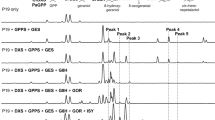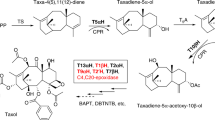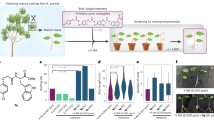Abstract
Momilactones from rice have allelopathic activity, the ability to inhibit growth of competing plants. Transferring momilactone production to other crops is a potential approach to combat weeds, yet a complete momilactone biosynthetic pathway remains elusive. Here, we address this challenge through rapid gene screening in Nicotiana benthamiana, a heterologous plant host. This required us to solve a central problem: diminishing intermediate and product yields remain a bottleneck for multistep diterpene pathways. We increased intermediate and product titers by rerouting diterpene biosynthesis from the chloroplast to the cytosolic, high-flux mevalonate pathway. This enabled the discovery and reconstitution of a complete route to momilactones (>10-fold yield improvement in production versus rice). Pure momilactone B isolated from N. benthamiana inhibited germination and root growth in Arabidopsis thaliana, validating allelopathic activity. We demonstrated the broad utility of this approach by applying it to forskolin, a Hedgehog inhibitor, and taxadiene, an intermediate in taxol biosynthesis (~10-fold improvement in production versus chloroplast expression).

This is a preview of subscription content, access via your institution
Access options
Access Nature and 54 other Nature Portfolio journals
Get Nature+, our best-value online-access subscription
$29.99 / 30 days
cancel any time
Subscribe to this journal
Receive 12 print issues and online access
$259.00 per year
only $21.58 per issue
Buy this article
- Purchase on Springer Link
- Instant access to full article PDF
Prices may be subject to local taxes which are calculated during checkout





Similar content being viewed by others
Data availability
Data supporting the findings of this study are presented in the published article (including its Supplementary Information) or are available from the corresponding author upon reasonable request.
References
Benbrook, C. M. Trends in glyphosate herbicide use in the United States and globally. Environ. Sci. Eur. 28, 3 (2016).
Farooq, M., Jabran, K., Cheema, Z. A., Wahid, A. & Siddique, K. H. M. The role of allelopathy in agricultural pest management. Pest Manag. Sci. 67, 493–506 (2011).
Kato-Noguchi, H. & Peters, R. J. The role of momilactones in rice allelopathy. J. Chem. Ecol. 39, 175–185 (2013).
Kato-Noguchi, H., Hasegawa, M., Ino, T., Ota, K. & Kujime, H. Contribution of momilactone A and B to rice allelopathy. J. Plant Physiol. 167, 787–791 (2010).
Kato-Noguchi, H., Ino, T., Sata, N. & Yamamura, S. Isolation and identification of a potent allelopathic substance in rice root exudates. Physiol. Plant 115, 401–405 (2002).
Kato-Noguchi, H., Ota, K. & Kujime, H. Absorption of momilactone A and B by Arabidopsis thaliana L. and the growth inhibitory effects. J. Plant Physiol. 169, 1471–1476 (2012).
Toyomasu, T. et al. Diterpene phytoalexins are biosynthesized in and exuded from the roots of rice seedlings. Biosci. Biotechnol. Biochem. 72, 562–567 (2008).
Chung, I.-M., Hahn, S.-J. & Ahmad, A. Confirmation of potential herbicidal agents in hulls of rice, Oryza sativa. J. Chem. Ecol. 31, 1339–1352 (2005).
Jabran, K. & Farooq, M. Implications of potential allelopathic crops in agricultural systems. in Allelopathy (eds. Cheema, Z. A., Farooq, M. & Wahid, A.) https://doi.org/10.1007/978-3-642-30595-5_15 (Springer, 2013).
Kato, T. et al. Momilactones, growth inhibitors from rice, Oryza sativa L. Tetrahedron Lett. 14, 3861–3864 (1973).
Chung, I. M., Kim, J. T. & Kim, S.-H. Evaluation of allelopathic potential and quantification of momilactone A,B from rice hull extracts and assessment of inhibitory bioactivity on paddy field weeds. J. Agric. Food Chem. 54, 2527–2536 (2006).
Quan, N. V. et al. Momilactones A and B are α-amylase and α-glucosidase inhibitors. Molecules 24, 482 (2019).
Paddon, C. J. et al. High-level semi-synthetic production of the potent antimalarial artemisinin. Nature 496, 528–532 (2013).
Li, Y. et al. Complete biosynthesis of noscapine and halogenated alkaloids in yeast. Proc. Natl Acad. Sci. USA 115, E3922–E3931 (2018).
Brown, S., Clastre, M., Courdavault, V. & O’Connor, S. E. De novo production of the plant-derived alkaloid strictosidine in yeast. Proc. Natl Acad. Sci. USA 112, 3205–3210 (2015).
Qu, Y. et al. Completion of the seven-step pathway from tabersonine to the anticancer drug precursor vindoline and its assembly in yeast. Proc. Natl Acad. Sci. USA 112, 6224–6229 (2015).
Luo, X. et al. Complete biosynthesis of cannabinoids and their unnatural analogues in yeast. Nature 567, 123–126 (2019).
Paine, J. A. et al. Improving the nutritional value of Golden Rice through increased pro-vitamin A content. Nat. Biotechnol. 23, 482–487 (2005).
Lau, W. & Sattely, E. S. Six enzymes from mayapple that complete the biosynthetic pathway to the etoposide aglycone. Science 349, 1224–1228 (2015).
Pateraki, I. et al. Total biosynthesis of the cyclic AMP booster forskolin from Coleus forskohlii. eLife 6, e23001 (2017).
Caputi, L. et al. Missing enzymes in the biosynthesis of the anticancer drug vinblastine in Madagascar periwinkle. Science 360, 1235–1239 (2018).
Hodgson, H. et al. Identification of key enzymes responsible for protolimonoid biosynthesis in plants: opening the door to azadirachtin production. Proc. Natl Acad. Sci. USA 116, 17096–17104 (2019).
Polturak, G. et al. Elucidation of the first committed step in betalain biosynthesis enables the heterologous engineering of betalain pigments in plants. New Phytol. 210, 269–283 (2016).
Crocoll, C., Mirza, N., Reichelt, M., Gershenzon, J. & Halkier, B. A. Optimization of engineered production of the glucoraphanin precursor dihomomethionine in Nicotiana benthamiana. Front. Bioeng. Biotechnol. 4, 14 (2016).
Xu, M., Hillwig, M. L., Prisic, S., Coates, R. M. & Peters, R. J. Functional identification of rice syn-copalyl diphosphate synthase and its role in initiating biosynthesis of diterpenoid phytoalexin/allelopathic natural products. Plant J. 39, 309–318 (2004).
Otomo, K. et al. Biological functions of ent- and syn-copalyl diphosphate synthases in rice: key enzymes for the branch point of gibberellin and phytoalexin biosynthesis. Plant J. 39, 886–893 (2004).
Otomo, K. et al. Diterpene cyclases responsible for the biosynthesis of phytoalexins, momilactones A, B, and oryzalexins A–F in rice. Biosci. Biotechnol. Biochem. 68, 2001–2006 (2004).
Wilderman, P. R., Xu, M., Jin, Y., Coates, R. M. & Peters, R. J. Identification of syn-pimara-7,15-diene synthase reveals functional clustering of terpene synthases involved in rice phytoalexin/allelochemical biosynthesis. Plant Physiol. 135, 2098–2105 (2004).
Wang, Q., Hillwig, M. L. & Peters, R. J. CYP99A3: functional identification of a diterpene oxidase from the momilactone biosynthetic gene cluster in rice. Plant J. 65, 87–95 (2011).
Wang, Q. et al. Characterization of CYP76M5-8 indicates metabolic plasticity within a plant biosynthetic gene cluster. J. Biol. Chem. 287, 6159–6168 (2012).
Kitaoka, N., Wu, Y., Xu, M. & Peters, R. J. Optimization of recombinant expression enables discovery of novel cytochrome P450 activity in rice diterpenoid biosynthesis. Appl. Microbiol. Biotechnol. 99, 7549–7558 (2015).
Shimura, K. et al. Identification of a biosynthetic gene cluster in rice for momilactones. J. Biol. Chem. 282, 34013–34018 (2007).
Henry, L. K. et al. Contribution of isopentenyl phosphate to plant terpenoid metabolism. Nat. Plants 4, 721–729 (2018).
Reed, J. et al. A translational synthetic biology platform for rapid access to gram-scale quantities of novel drug-like molecules. Metab. Eng. 42, 185–193 (2017).
Brückner, K. & Tissier, A. High-level diterpene production by transient expression in Nicotiana benthamiana. Plant Methods 9, 46 (2013).
van Herpen, T. W. J. M. et al. Nicotiana benthamiana as a production platform for artemisinin precursors. PLoS ONE 5, e14222 (2010).
Wendt, K. U. & Schulz, G. E. Isoprenoid biosynthesis: manifold chemistry catalyzed by similar enzymes. Structure 6, 127–133 (1998).
Wildung, M. R. & Croteau, R. A cDNA clone for taxadiene synthase, the diterpene cyclase that catalyzes the committed step of taxol biosynthesis. J. Biol. Chem. 271, 9201–9204 (1996).
Bohlmann, J., Meyer-Gauen, G. & Croteau, R. Plant terpenoid synthases: molecular biology and phylogenetic analysis. Proc. Natl Acad. Sci. USA 95, 4126–4133 (1998).
Zerbe, P. & Bohlmann, J. Plant diterpene synthases: exploring modularity and metabolic diversity for bioengineering. Trends Biotechnol. 33, 419–428 (2015).
Andersen-Ranberg, J. et al. Expanding the landscape of diterpene structural diversity through stereochemically controlled combinatorial biosynthesis. Angew. Chem. Int. Ed. Engl. 55, 2142–2146 (2016).
Pateraki, I. et al. Manoyl oxide (13R), the biosynthetic precursor of forskolin, is synthesized in specialized root cork cells in Coleus forskohlii. Plant Physiol. 164, 1222–1236 (2014).
Wang, Q., Hillwig, M. L., Wu, Y. & Peters, R. J. CYP701A8: a rice ent-kaurene oxidase paralog diverted to more specialized diterpenoid metabolism. Plant Physiol. 158, 1418–1425 (2012).
Christ, B. et al. Repeated evolution of cytochrome P450-mediated spiroketal steroid biosynthesis in plants. Nat. Commun. 10, 3206 (2019).
Liu, Q. et al. Reconstitution of the costunolide biosynthetic pathway in yeast and Nicotiana benthamiana. PLoS ONE 6, e23255 (2011).
Dickschat, J. S., Rinkel, J., Rabe, P., Beyraghdar Kashkooli, A. & Bouwmeester, H. J. 18-Hydroxydolabella-3,7-diene synthase—a diterpene synthase from Chitinophaga pinensis. Beilstein J. Org. Chem. 13, 1770–1780 (2017).
Dong, L., Jongedijk, E., Bouwmeester, H. & Van Der Krol, A. Monoterpene biosynthesis potential of plant subcellular compartments. New Phytol. 209, 679–690 (2016).
Lange, B. M. & Turner, G. W. Terpenoid biosynthesis in trichomes—current status and future opportunities. Plant Biotechnol. J. 11, 2–22 (2013).
Tissier, A. Trichome specific expression: promoters and their applications. in Transgenic Plants—Advances and Limitations (ed. Ozden Ciftci, Y.) https://doi.org/10.5772/1409 (InTech, 2012).
Ceunen, S. & Geuns, J. M. C. Steviol glycosides: chemical diversity, metabolism, and function. J. Nat. Prod. 76, 1201–1228 (2013).
Learned, R. M. & Fink, G. R. 3-Hydroxy-3-methylglutaryl-coenzyme A reductase from Arabidopsis thaliana is structurally distinct from the yeast and animal enzymes. Proc. Natl Acad. Sci. USA 86, 2779–2783 (1989).
Estévez, J. M., Cantero, A., Reindl, A., Reichler, S. & León, P. 1-Deoxy-d-xylulose-5-phosphate synthase, a limiting enzyme for plastidic isoprenoid biosynthesis in plants. J. Biol. Chem. 276, 22901–22909 (2001).
Sainsbury, F., Thuenemann, E. C. & Lomonossoff, G. P. pEAQ: versatile expression vectors for easy and quick transient expression of heterologous proteins in plants. Plant Biotechnol. J. 7, 682–693 (2009).
Emanuelsson, O., Nielsen, H. & von Heijne, G. ChloroP, a neural network-based method for predicting chloroplast transit peptides and their cleavage sites. Protein Sci. 8, 978–984 (1999).
Sperschneider, J. et al. LOCALIZER: subcellular localization prediction of both plant and effector proteins in the plant cell. Sci. Rep. 7, 44598 (2017).
Marcel, S., Sawers, R., Oakeley, E., Angliker, H. & Paszkowski, U. Tissue-adapted invasion strategies of the rice blast fungus Magnaporthe oryzae. Plant Cell 22, 3177–3187 (2010).
Acknowledgements
This work was supported by National Institutes of Health (NIH) U01 grant GM110699 and NIH R01 grant GM121527. We thank C. Liou and K. Smith for discussions and feedback on the manuscript. We thank E. Holmes, Y. Chen and J. Kim for help in developing Arabidopsis inhibition assays; H. Cartwright at the Advanced Imaging Facility in the Carnegie Institution for Science, Department of Plant Biology, for training and assistance with confocal microscopy imaging; C. Miller for help with confocal imagining analysis; and K. Smith and S. Kim for help with flash column purification and NMR analysis.
Author information
Authors and Affiliations
Contributions
R.D.L.P. and E.S.S. designed the experiments. R.D.L.P. performed experiments. R.D.L.P. and E.S.S. analyzed the data and wrote the paper.
Corresponding author
Ethics declarations
Competing interests
The authors declare no competing interests.
Additional information
Publisher’s note Springer Nature remains neutral with regard to jurisdictional claims in published maps and institutional affiliations.
Extended data
Extended Data Fig. 1 Characterization of pathway intermediates from overexpression of cytOsCPS4 + cytOsKSL4 via MEV engineering.
GC-MS total ion chromatogram (TIC) and MS spectra of major and minor pathway products from overexpression of HMGR, cytGGPPS, cytOsCPS4, and cytOsKSL4 in N. benthamiana. Representative TICs are shown for the experimental sample and GFP control. Three total products with m/z corresponding to diterpene derived scaffolds were observed only upon expression of pathway genes. The major product identified corresponded to 1 and putative structures for two minor products were hypothesized. For m/z corresponding to syn-copalyl alcohol see Supplemental Fig. 9. Putative ion structures for the major product were assigned as reference. Putative structures are preliminary and based on predicted chemical formulas combined with analysis of the fragment ions observed in the MS spectra.
Extended Data Fig. 2 Characterization of pathway intermediates from overexpression of cytOsCPS4 + cytOsKSL4 + CYP99A3 via MEV engineering.
GC-MS total ion chromatogram (TIC) and MS spectra of products from overexpression of HMGR, cytGGPPS, cytOsCPS4, cytOsKSL4, and CYP99A3 in N. benthamiana. Representative TICs are shown for the experimental sample and controls. Three products with m/z corresponding to diterpene derived scaffolds were observed only upon expression of pathway genes. The major product identified corresponded to 2 and the two minor products corresponded to syn-pimaradien-19-al and syn-pimaradien-19-ol29. For m/z corresponding to syn-copalyl alcohol see Supplementary Fig. 9. Putative ion structures for 2 were assigned as reference. Putative structures are preliminary and based on predicted chemical formulas combined with analysis of the fragment ions observed in the MS spectra. An endogenous metabolite co-eluting with 2 was identified (* in the TIC). b, MS spectra of endogenous metabolite. c, GC-MS extracted ion chromatogram (EIC) using m/z = 241.2, corresponding to an abundant fragment found in the MS of 2, confirmed that 2 is only present upon expression of the requisite diTPSs and CYP99A3.
Extended Data Fig. 3 Characterization of pathway intermediates from overexpression of cytOsCPS4 + cytOsKSL4 + CYP76M8 via MEV engineering.
GC-MS total ion chromatogram (TIC) and MS spectra of major and minor pathway products from overexpression of HMGR, cytGGPPS, cytOsCPS4, cytOsKSL4, and CYP76M8 in N. benthamiana. Representative TICs are shown for the experimental sample and the no diterpene synthase control. Three total products with m/z corresponding to diterpene derived scaffolds were observed only upon expression of pathway genes. The major product identified corresponded to syn-pimaradien-6-ol and putative structures for two minor products were hypothesized (For syn-copalyl alcohol see Supplemental Fig. 9, for *, corresponding to an endogenous metabolite, see Extended Data Fig. 2). Putative ion structures for the major product were assigned as reference. Putative structures are preliminary and based on predicted chemical formulas combined with analysis of the fragment ions observed in the MS spectra.
Extended Data Fig. 4 Characterization of pathway intermediates from overexpression of cytOsCPS4 + cytOsKSL4 + CYP99A3 + CYP76M8 via MEV engineering.
GC-MS total ion chromatogram (TIC) and MS spectra of products from overexpression of HMGR, cytGGPPS, cytOsCPS4, cytOsKSL4, CYP99A3, and CYP76M8 in N. benthamiana. Representative TICs are shown for the experimental sample and controls. Products with m/z corresponding to diterpene derived scaffolds were observed only upon expression of pathway genes. Putative ion structures for 4, 5, and 2G were assigned as reference. Putative structures are preliminary and based on predicted formulas combined with analysis of the fragment ions observed in the MS spectra.
Extended Data Fig. 5 Oxidation of syn-pimaradiene scaffold via overexpression of various tailoring oxidases.
a, Oxidation of syn-pimaradiene can proceed via overexpression of either CYP99A3 or CYP76M8. n=3 biological independent leaf samples examined over three independent experiments. b, Overexpression of OsMAS, CYP99A3 and CYP76M8 is required for biosynthesis of the lactone ring in 6 and 8. Average GC-MS ion abundances of oxidized syn-pimaradiene scaffolds after overexpression of indicated genes via cytosolic engineering. Values and error bars represent the mean and the standard deviation of biological triplicates. n=3 biological independent leaf samples examined over three independent experiments.
Extended Data Fig. 6 Characterization of pathway intermediates from overexpression of cytOsCPS4 + cytOsKSL4 + CYP99A3 + CYP76M8 + OsMAS via MEV engineering.
GC-MS total ion chromatogram (TIC) and MS spectra of major and minor pathway products from overexpression of HMGR, cytGGPPS, cytOsCPS4, cytOsKSL4, CYP99A3, CYP76M8, and OsMAS in N. benthamiana. Representative TICs are shown for the experimental sample and the no diterpene synthase control. Four total products with m/z corresponding to diterpene derived scaffolds were observed only upon expression of pathway genes. Two major products identified corresponded to 6 and 8, and putative structures for two minor products were hypothesized. Putative ion structures for the major product were assigned as reference. Putative structures are preliminary and based on predicted chemical formulas combined with analysis of the fragment ions observed in the MS spectra.
Extended Data Fig. 7 Expression of OsMAS results in the reduction of levels of several oxidized syn-pimaradiene scaffolds.
Average GC-MS ion abundances of oxidized syn-pimaradiene intermediates after overexpression of indicated genes via cytosolic engineering. Co-expression with OsMAS results in reduction of levels of 4, 5, and increase in levels of 6. Values and error bars represent the mean and the standard deviation of biological triplicates. n=3 biological independent leaf samples examined over three independent experiments. P values were calculated using unpaired, two-tailed t-tests.
Extended Data Fig. 8 Characterization of pathway intermediates from overexpression of cytOsCPS4 + cytOsKSL4 + CYP99A3 + CYP76M8 + OsMAS + CYP76M14 + CYP701A8 via MEV engineering.
GC-MS total ion chromatogram (TIC) and MS spectra of products from overexpression of HMGR, cytGGPPS, cytOsCPS4, cytOsKSL4, CYP99A3, CYP76M8, OsMAS, CYP76M14, and CYP701A8 in N. benthamiana. Representative TICs are shown for the experimental sample and control. a, Two products with m/z corresponding to diterpene derived scaffolds were observed only upon expression of pathway genes. The products identified corresponded to momilactone B and 7. Putative ion structures were assigned as reference. Structures of 7 is preliminary and based on a predicted chemical formula combined with analysis of the fragment ions observed in the MS spectra. b, The major product identified corresponded to momilactone B (See Supplementary Figs. 11 and 12 for structural characterization).
Extended Data Fig. 9 Momilactone B inhibits A. thaliana seed germination.
a, Phenotype of A. thaliana seeds after 10 days of incubation in MS medium plates with different momilactone B concentrations. SA, salicylic acid.
Supplementary information
Supplementary Information
Supplementary Figs. 1–13 and Supplementary Tables 1–7
Rights and permissions
About this article
Cite this article
De La Peña, R., Sattely, E.S. Rerouting plant terpene biosynthesis enables momilactone pathway elucidation. Nat Chem Biol 17, 205–212 (2021). https://doi.org/10.1038/s41589-020-00669-3
Received:
Accepted:
Published:
Issue Date:
DOI: https://doi.org/10.1038/s41589-020-00669-3
This article is cited by
-
Reconstitution of early paclitaxel biosynthetic network
Nature Communications (2024)
-
Biosynthesis and biotechnological production of the anti-obesity agent celastrol
Nature Chemistry (2023)
-
Transcriptional response of a target plant to benzoxazinoid and diterpene allelochemicals highlights commonalities in detoxification
BMC Plant Biology (2022)
-
Reconstitution of monoterpene indole alkaloid biosynthesis in genome engineered Nicotiana benthamiana
Communications Biology (2022)
-
Ancient plant-like terpene biosynthesis in corals
Nature Chemical Biology (2022)



